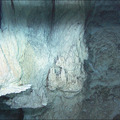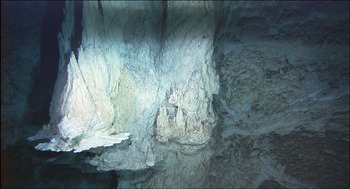
Delicate carbonate chimneys and deposits reminiscent of "upturned hands" are common alon ...

Carbonate chimney growing from serpentinite cliff
The core of the Lost City field is dominated by the actively venting carbonate monolith called Poseidon that rises >60 m above the seafloor. This composite structure is comprised of four large columns that are several meters in diameter, which coalesce at their base to form a massive east-west trending structure extending at least 50 m. Parasitic chimneys, resembling inverted stalactites, are particularly abundant on the northwest face, as are actively venting flanges, or ledges that protrude several meters from the main trunk. The active chimneys are composed of aragonite and calcite (CaCO3), with lesser brucite [Mg(OH)2], but as the chimneys age and die, they are dominated by calcite. Dating by Ludwig et al., (2010) shows this to be the most long-lived submarine hydrothermal system known in the worlds’ oceans with activity lasting for at least 150,000 years.
One of the most visually striking region is just northeast of Poseidon. Here the vertical serpentinite cliffs are draped by deposits with astoundingly diverse vent morphologies. Fluids weeping from the scarp face have produced clusters of delicate, multi-pronged carbonate growths that extend outward like the fingers of upturned hands. Multi-pinnacled chimneys, some reaching 10 m in height, grow vertically out of the cliff faces and single chimneys that sprout from more gently dipping bedrock reach 30 m in height. These structures form a nearly continuous carbonate deposit that can be traced for over 200 m in length. Control of the hydrothermal outflow by fractures is particularly obvious where walls of massive, shingled carbonate have been deposited on the steep scarps, highlighting that much of the LCHF plumbing system is in marked contrast to the vertical conduits that typify black smoker environments and continental sulfide deposits.




